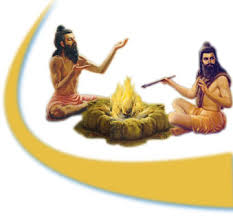 |
|
The oldest Scriptures in all of India and the most important are called the vedas. All Hindus recognize the Vedas as the true origin of their faith because of the spiritual meaning behind them. The Scriptures served as a base for inner searching among the Indo-Aryan people as they were composed by seers or ancient prophets while in a state of inspiration. There are four Vedas: Rig Veda, Sama Veda, Yajur Veda and Atharva Veda. Each is divided into two groups: works and knowledge. The first is made of hymns and instructions regarding rights, ceremonies and rules of conduct. The latter is concerned with knowledge of who god is. The Rig Veda in all probability was composed between 1500 BC and 900 BC (Walker, p.215). During this time period more than 200 canons of Scripture were produced. At the end of this era (800 BC to 400 BC) the Vendanta (meaning “end of the vedas”) writings were completed. Although the Vedas were still held in high regard, several “seekers” felt that people were still searching for the meaning of life. The people needed something more than the Vedas to fulfill their needs. After deep contemplation, these seekers compiled the wise words and sayings of the gurus from whom they attained spiritual knowledge and wisdom. This collection of teachings became known as the Upanishads and the seekers themselves were given the name Upanishads that literally meant “came near to” the gurus. It seems that the Upanishads were created as an Indo-Aryan reaction to the previous sacrificial rituals they were finding unsatisfactory. The Upanishad texts were writings comprised to further develop spiritual knowledge already attained in the vedic scriptures. The spiritual doctrine of these additional texts attempted to reach beyond the traditional vedic concept of reality which was more of a physical concept. The major concepts of the Upanishads are ultimately man’s greatest dilemmas: the nature of god and man, the soul and god, man’s role in the world and how they relate, the purpose of existence, and true salvation (Walker, p. 215). The difference between the Vedas and the Upanishad scriptures seems to be that the Vedas are held as the true foundation of their faith (the Hindu faith) and the Upanishads are the actual vehicle to attaining this enlightenment which brings them to a oneness with existence. Throughout history, the Hindu people have constantly been seeking the meaning of life. This search can be seen through the Vedas and Upanishads as they seek to relate to god and the world and to find true salvation. The Hindu faith stems mainly from the ancient vedic scriptures and evolved to include the Upanishads. Modern Hindus would agree that the Upanishads are a necessary addition to the Vedas. The evolving of these texts was the first consistent expression that directed the people to a philosophical solution to their spiritual dilemmas, questions, and problems.


0 comments:
Post a Comment